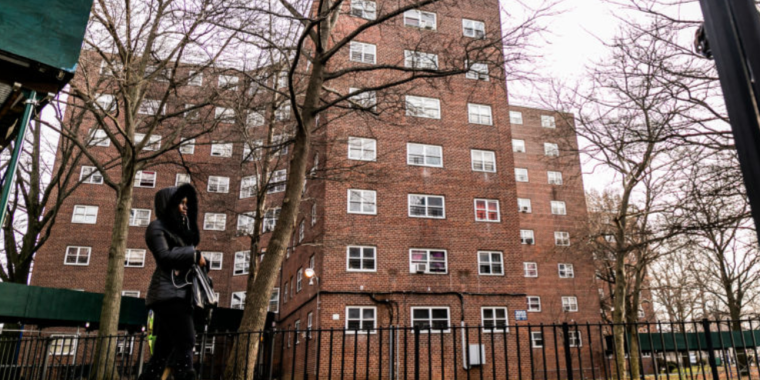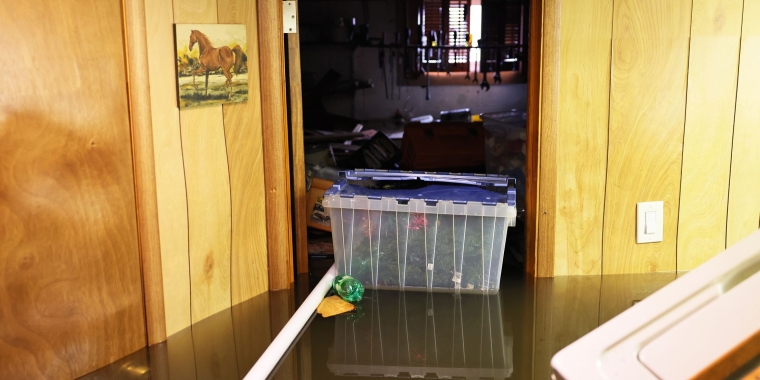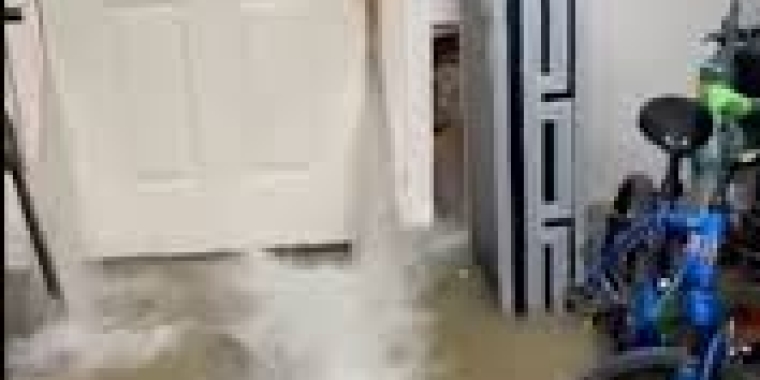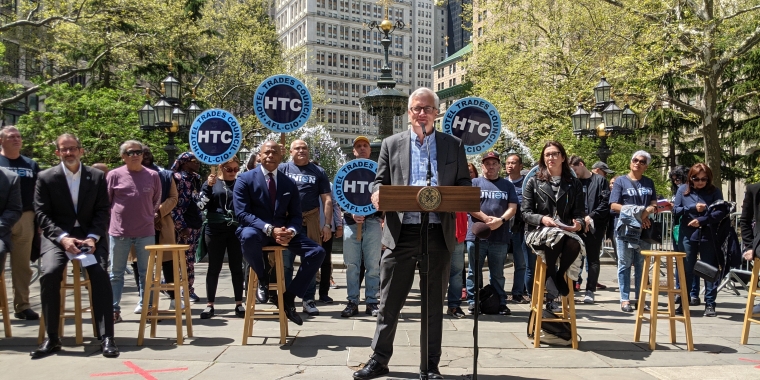City Limits Covers Housing Portions of State Budget

State legislators had proposed $750 million towards NYCHA, but within the final budget, the country’s largest public housing agency received $200 million, Adi Talwar
On April 13, 2021, Sadef Ali Kully of City Limits covered the housing portions of the recently passed State budget, including Senator Kavanagh's work on the $2.4 billion COVID-19 Emergency Rental Assistance Program, capital funding for public housing, and funding for permanent housing for New Yorkers experiencing homelessness. The full text of the article is below; the original version is available via the link above.
_______________
NYS Budget on Housing: Rent Relief Victory, Disappointment on NYCHA and Homelessness
While housing advocates say the budget deal included a major victory for tenants––creating a multi-billion dollar program for rent relief––it included less funds for NYCHA and homelessness prevention than stakeholders had hoped for.
By Sadef Ali Kully
April 13, 2021
Last week, lawmakers in Albany passed a $212 billion budget package, part of an effort to help New York State recover economically from the impact of the COVID-19 pandemic. While housing advocates say the deal included a major victory for tenants––creating a multi-billion dollar program for rent relief, to prevent the thousands of statewide evictions projected for low- to middle-income New York households––it did not come without a couple of losses, including less funds for NYCHA and homelessness prevention than stakeholders had hoped for.
“The state legislature just completely buckled to Governor Cuomo on our homelessness priorities. It’s really immoral because homeless New Yorkers in the city are dying at a rate of COVID that is 78 percent higher than those people who are housed,” said Cea Weaver, coordinator with Housing Justice for All. “We’ve been fighting for a long time to get real permanent resources to put New York State on the path to end homelessness in the state budget. And it’s just immoral that didn’t make the cut this year, of all years.”
Housing budget letdowns
Among the biggest disappointments for housing advocacy groups and elected officials was when a permanent housing initiative for homeless individuals, proposed by State Sen. Brian Kavanagh in February, did not make it into the final budget. Kavanagh’s proposed $200 million Housing Access Voucher Program (HAVP) would function similarly to the federal Section 8 program, providing rental assistance for homeless New Yorkers or those at risk of losing their housing. Undocumented New Yorkers would be eligible to apply, since the program would not be funded by federal monies and therefore not restricted to the same federal regulations that the Section 8 program is.
While HAVP did not make it into the final budget deal, lawmakers did include $100 million for the Permanent Housing for Homeless New Yorkers, a new rental supplement program for homeless households or those facing a possible eviction. This program would also accommodate undocumented New Yorkers, and would be administered under the Office of Temporary and Disability Assistance (OTDA) and the state Budget office. But homeless advocacy groups say the initiative is too bureaucratic, and gives localities the choice to opt into the program, weakening its effectiveness.
“They are asking counties to opt into it. It’s not a mandate from the state. After they opt in, they have to apply to OTDA and the department of Budget, submit … plans on how they’re going to use the funds, and then the state has discretion basically to accept it or not,” said Paulette Soltani, policy director at VOCAL-NY, a homelessness advocacy group.
Soltani says the program also does not pay full fair market rents, so it may not appeal to landlords. According to legislative records, the rental supplement will pay 85 percent or higher of fair market rent at local costs for households earning up to 50 percent of the area median income, or AMI (which translates to $51,200 for a family of three). Soltani says fully funding the entire amount of rent is more appealing for landlords over other incentives.
Kavanagh said he was disappointed that his program didn’t make it in the final state budget, but added the new homeless supplement program is a step in the right direction, though it may require a little more effort.
“OTDA is going to need to work hard to get this program up and running. And the localities are going to have to opt in, but we are going to work hard to try to make this program as real, as possible and as effective as possible in the coming year,” he said about holding the program accountable as it is being implemented. “$100 million will allow you to house a great many people.”
Similarly, Senator Michael Gianaris’ proposal, Housing Our Neighbors with Dignity Act (HONDA), did not make it into the final budget deal. The $250 million plan would have created a pathway to repurpose distressed commercial properties into affordable housing run by nonprofit groups. State legislators did allocate a smaller amount––$100 million––to support the conversion of underused and distressed hotels and other commercial properties into permanent affordable housing, an effort to be administered by the state’s Division of Housing and Community Renewal (DCHR).
Funding for NYCHA also came in lower than some lawmakers and advocates were aiming. State legislators had proposed $750 million towards NYCHA for capital repairs, but within the final budget, the country’s largest public housing agency received $200 million; another $125 million was included for the state’s public housing outside of New York City. The housing authority has long faced financial strain: recent analysis from the city’s Independent Budget Office found that NYCHA is projecting a $300 million budget shortfall in 2022, a major increase since December 2019, when NYCHA projected a $75 million deficit.
Judith Goldiner, attorney-in-charge at the Legal Aid Society’s Civil Law Reform Unit, says the focus for many housing advocacy groups in this year’s budget negotiations was geared towards preventing evictions in the private housing market due to the impact of the pandemic. As a landlord, NYCHA has one of the lower eviction rates in the city due to its income-based rent policy, she added.
“The problem with state funding for NYCHA, for a long time, has been that [NYCHA] doesn’t necessarily get it. The state doesn’t necessarily release the money to them,” said Goldiner, referring to past struggles to get the state to release funding it had set aside for public housing.
Goldiner credited Kavanagh and Assemblymember Steven Cymbrowitz, both chairs of the housing committee in the Senate and Assembly respectively, for NYCHA receiving the $200 million it did, saying both pushed for the funds––the most the public housing agency has received from the state in a single fiscal period in recent years. NYCHA currently needs an estimated $40 billion in repairs and infrastructure upgrades.
Rent relief for many New Yorkers
The biggest pool of funds for housing included in this year’s budget is the multi-billion dollar rent relief package, which stakeholders say is critical to addressing the rental arrears gap in the private housing market brought on by the pandemic. The $2.4 billion slated for rent relief will provide up to 12 months of rent and utilities arrears, three prospective months of rent and one year of eviction protection to approved participants. The program will be administered by the OTDA and will be eligible to New Yorkers earning up to 80 percent of the Area Median Income, (equivalent to $81,920 for a household of three).
According to Kavanagh, the program is expected to hit the ground running: OTDA is currently developing an online portal system that will begin accepting applications on a rolling basis once it opens.
Housing advocacy and real estate groups are hoping this new rent relief program will work better than similar initiatives introduced over the past year. During the height of the pandemic, the state legislature approved the Emergency Rent Relief Act (ERRA) of 2020 after receiving $100 million through the federal Coronavirus Aid, Relief and Economic Security (CARES) Act. The program was designed to aid rent-burdened households that lost income during the pandemic, but the criteria set by the Trump administration was overly restrictive: it would not cover tenants who received unemployment or cash benefits, Section 8 Housing Choice Vouchers, public housing residents with rent more than 30 percent of their household income or those who earned more than 80 percent of AMI ($81,920 for a family of three). To date, the program has distributed less than half of its allocated funding. The remainder––an estimated 60 million––is slated to be folded into the new rent relief program in some form.
The Real Estate Board of New York (REBNY) and the Rent Stabilization Association (RSA) both expressed concern on how quickly the new rent relief program would be able to distribute funds to waiting tenants and landlords.
“We’re hopeful that whatever they come out with is simple and direct, not too complicated. Because I think that’s what undermined the first program that was approved a little over a year ago,” said RSA executive vice president Frank Ricci.
“Given the record level of spending reflected in this budget, it is only fair to expect a measurably improved delivery of services by the government and better quality of life for the State’s residents and businesses,” said REBNY President James Whelan in an email statement. “We are pleased that State officials approved a program for distributing federal rental assistance funds. These funds must be distributed as quickly and effectively as possible.”
The RSA also raised concern about the lack of specific language in the new program around evictions. The rent relief initiative included in the budget halts evictions for up to one year once the relief funds have been received by the participating tenant or landlord. Ricci said last year’s rent relief program specified that despite an eviction moratorium, exceptions could be made for nuisance evictions––those filed by landlords against tenants who have a history of harassing behavior such as constant noise, sexual harassment of other tenants or disrupting the quality of life for other residents.
Kavanagh said there is no specific language in the new bill that prevents landlords from pursuing nuisance evictions in housing court, but landlords noted that there was also no language specifically making an exception for such evictions.
“There’s some difference of opinion from legal experts––if you accept [the rent relief] money, can you still proceed with a nuisance eviction,” says Ricci. “So that would be the one area of concern that jumped out at us.”
Kavanagh said there were many lessons learned from the first rent relief program. The new program will have an online system that will accept applications on a rolling basis, and will be available in several languages. But community organizations in every locality will be critical to how quickly information about rent relief reaches tenants; he expects New York City to be one of the biggest recipients of the program. The state budget included a boost in administration funds as well as outreach funding to contract with nonprofit organizations to get the word out and to help tenants and landlords in their communities apply for the relief.
“We’re hoping that the processes of people becoming aware of it and people being able to apply will be smoother and quicker,” than previous rent relief efforts, Kavanagh says, adding that he expects the new program to kick off in the coming weeks. An estimated 800,000 to 1.2 million households are expected to benefit from the program, he said.
Other housing initiatives funded in the recent budget deal include the Homeownership Relief and Protection Program, which is slated to receive $600 million in federal funding to aid homeowners with mortgage, utility, or home energy payments, among other related expenses. Included within that funding, state legislators restored $20 million annually for the Homeowner Protection Program (HOPP) over the next three years, which aids property owners at risk of losing their homes with loan modifications or free legal services in court. Additionally, the state budget includes $25 million to rehab distressed properties and convert them into affordable homes for first-time buyers.
###



